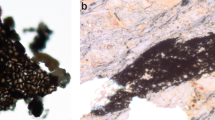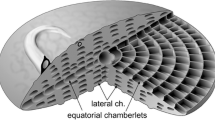Abstract
Phosphatized microfossils in the Ediacaran (635–542 Myr ago) Doushantuo Formation, south China, have been interpreted as the embryos of early animals1,2,3,4. Despite experimental demonstration that embryos can be preserved5, microstructural evidence that the Doushantuo remains are embryonic6 and an unambiguous record of fossil embryos in Lower Cambrian rocks7, questions about the phylogenetic relationships of these fossils remain. Most recently, some researchers have proposed8 that Doushantuo microfossils may be giant sulphur-oxidizing bacteria comparable to extant Thiomargarita sp. Here we report new observations that provide a test of the bacterial hypothesis. The discovery of embryo-like Doushantuo fossils inside large, highly ornamented organic vesicles (acritarchs) indicates that these organisms were eukaryotic, and most probably early cleavage stage embryos preserved within diapause egg cysts. Large acanthomorphic microfossils of the type observed to contain fossil embryos first appear in rocks just above a 632.5 ± 0.5-Myr-old ash bed9, suggesting that at least stem-group animals6 inhabited shallow seas in the immediate aftermath of global Neoproterozoic glaciation.


Similar content being viewed by others
References
Xiao, S., Zhang, Y. & Knoll, A. H. Three-dimensional preservation of algae and animal embryos in a Neoproterozoic phosphorite. Nature 391, 553–558 (1998)
Xiao, S. & Knoll, A. H. Phosphatized animal embryos from the Neoproterozoic Doushantuo Formation at Weng’an, Guizhou, South China. J. Paleontol. 74, 767–788 (2000)
Chen, J. et al. Small bilaterian fossils from 40 to 55 million years before the Cambrian. Science 305, 218–222 (2006)
Dornbos, S. Q. et al. Environmental controls on the taphonomy of phosphatized animals and animal embryos from the Neoproterozoic Doushantuo Formation, southwest China. Palaios 21, 3–14 (2006)
Raff, E. C., Villinski, J. T., Turner, F. R., Donoghue, P. C. J. & Raff, R. A. Experimental taphonomy shows the feasibility of fossil embryos. Proc. Natl Acad. Sci. USA 103, 5846–5851 (2006)
Hagadorn, J. W. et al. Cellular and subcellular structure of Neoproterozoic animal embryos. Science 314, 291–294 (2006)
Donoghue, P. C. J. et al. Fossilized embryos are widespread but the record is temporally and taxonomically biased. Evol. Dev. 8, 232–238 (2006)
Bailey, J. V., Joye, S. B., Kalanetra, K. M., Flood, B. E. & Corsetti, F. A. Evidence of giant sulfur bacteria in Neoproterozoic phosphorites. Nature 445, 198–201 (2007)
Condon, D. et al. U-Pb ages from the Neoproterozoic Doushantuo Formation, China. Science 308, 95–98 (2005)
Donoghue, P. C. J. Embryonic identity crisis. Nature 445, 155–156 (2007)
Xiao, S., Hagadorn, J. W., Zhou, C. & Yuan, X. Rare helical spheroidal fossils from the Doushantuo Lagerstätte: Ediacaran animal embryos come of age? Geology 35, 115–118 (2007)
Knoll, A. H., Javaux, E. J., Hewitt, D. & Cohen, P. Eukaryotic organisms in Proterozoic oceans. Phil. Trans. Roy. Soc. B 361, 1023–1038 (2006)
Zhang, Y., Yin, L., Xiao, S. & Knoll, A. H. Permineralized fossils from the terminal Proterozoic Doushantuo Formation, south China. J. Paleontol. 72 (Suppl. to no. 4) 1–52 (1998)
Yuan, X. & Hofmann, H. J. New micropaleontological data from Neoproterozoic Sinica Doushantuo phosphorite rocks, Weng’an, Guizhou Province, southwestern China. Alcheringa 22, 189–222 (1998)
Van Waveren, I. & Marcus, N. H. Morphology of recent copepod egg envelopes from Turkey Point, Gulf of Mexico, and their implications for acritarch affinity. Spec. Pap. Paleontol. 48, 111–124 (1993)
Buckland-Nicks, J. Hull cupules of chiton eggs: parachute structures and sperm focusing devices? Biol. Bull. 184, 269–276 (1993)
Yin, C., Bengtson, S. & Yue, Z. Silicified and phosphatized Tianzhushania, spheroidal microfossils of possible animal origin from the Neoproterozoic of South China. Acta Palaeontol. Pol. 49, 1–12 (2004)
Grey, K. Ediacaran palynology of Australia. Mem. Assoc. Australas. Palaeontologists 31, 1–439 (2005)
Marcus, N. H. & Boero, F. Minireview: The importance of benthic–pelagic coupling and the forgotten role of life cycles in coastal aquatic systems. Limnol. Oceanogr. 43, 763–768 (1998)
Zhu, M., Zhang, J. & Yang, A. Integrated Ediacaran (Sinian) chronostratigraphy of South China. Palaeogeogr. Palaeoclimatol. Palaeoecol. (in the press).
Barfod, G. H. et al. New Lu-Hf and Pb-Pb age constraints on the earliest animal fossils. Earth Planet. Sci. Lett. 201, 203–212 (2002)
Chen, D., Dong, W. Q., Qi, L., Chen, G. Q. & Chen, X. P. Pb-Pb ages of Neproterozoic Doushantuo phosphorites in South China: constraints on early metazoan evolution and glaciation events. Precambr. Res. 132, 123–222 (2004)
Zhou, C., Xie, G., Mcfadden, K., Xiao, S. & Yuan, X. The diversification and extinction of Doushantuo–Pertatataka acritarchs in South China: causes and biostratigraphic significance. Geol. J. 41, 1–34 (2006)
Hoffman, P. F., Kaufman, A. J., Halverson, G. P. & Schrag, D. P. A Neoproterozoic snowball earth. Science 281, 1342–1346 (1998)
Voreb’eva, N. G., Sergeev, V. N. & Knoll, A. H. Diverse Ediacaran acritarchs from the margin of the East European Platform. Geology (submitted).
Canfield, D. E., Poulton, S. W. & Narbonne, G. M. Late Neoproterozoic deep-ocean oxygenation and the rise of animal life. Science 10.1126/science.1135013. (2006)
Fike, D. A., Grotzinger, J. P., Pratt, L. M. & Summons, R. E. Oxidation of the Ediacaran ocean. Nature 444, 744–747 (2006)
Acknowledgements
This work was supported by the Chinese Academy of Sciences, the National Natural Science Foundation of China, the Major Basic Research Projects of MST of China, and an NSF Grant. We thank S. Xiao and P. Cohen for discussions.
Author information
Authors and Affiliations
Corresponding author
Ethics declarations
Competing interests
Reprints and permissions information is available at npg.nature.com/reprintsandpermissions. The authors declare no competing financial interests.
Rights and permissions
About this article
Cite this article
Yin, L., Zhu, M., Knoll, A. et al. Doushantuo embryos preserved inside diapause egg cysts. Nature 446, 661–663 (2007). https://doi.org/10.1038/nature05682
Received:
Accepted:
Issue Date:
DOI: https://doi.org/10.1038/nature05682
- Springer Nature Limited
This article is cited by
-
A Diverse Microfossil Assemblage from the Ediacaran–Cambrian Deep-Water Chert of the Liuchapo Formation in Guizhou Province, South China
Journal of Earth Science (2023)
-
Active methanogenesis during the melting of Marinoan snowball Earth
Nature Communications (2021)
-
Ultrastructure and in-situ chemical characterization of intracellular granules of embryo-like fossils from the early Ediacaran Weng’an biota
PalZ (2021)
-
Ediacaran Doushantuo-type biota discovered in Laurentia
Communications Biology (2020)
-
Ediacaran integrative stratigraphy and timescale of China
Science China Earth Sciences (2019)





